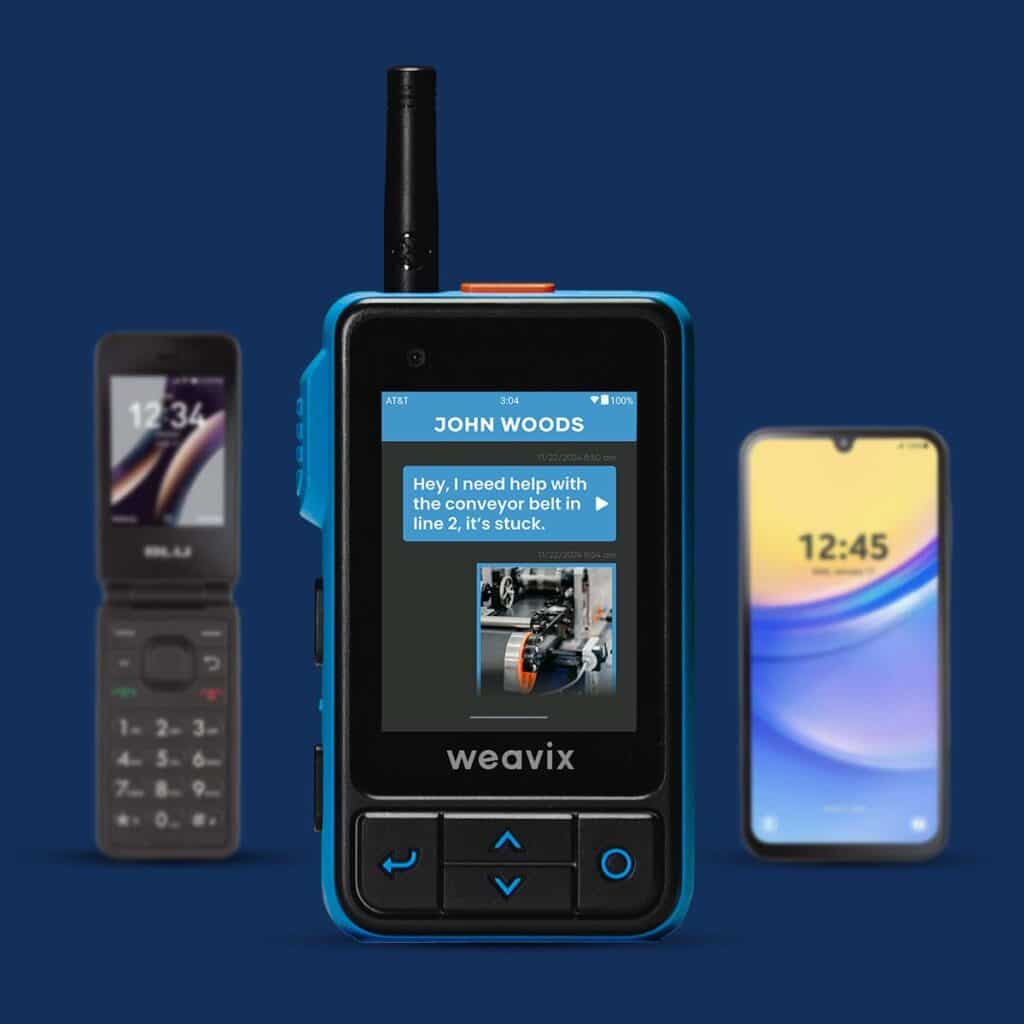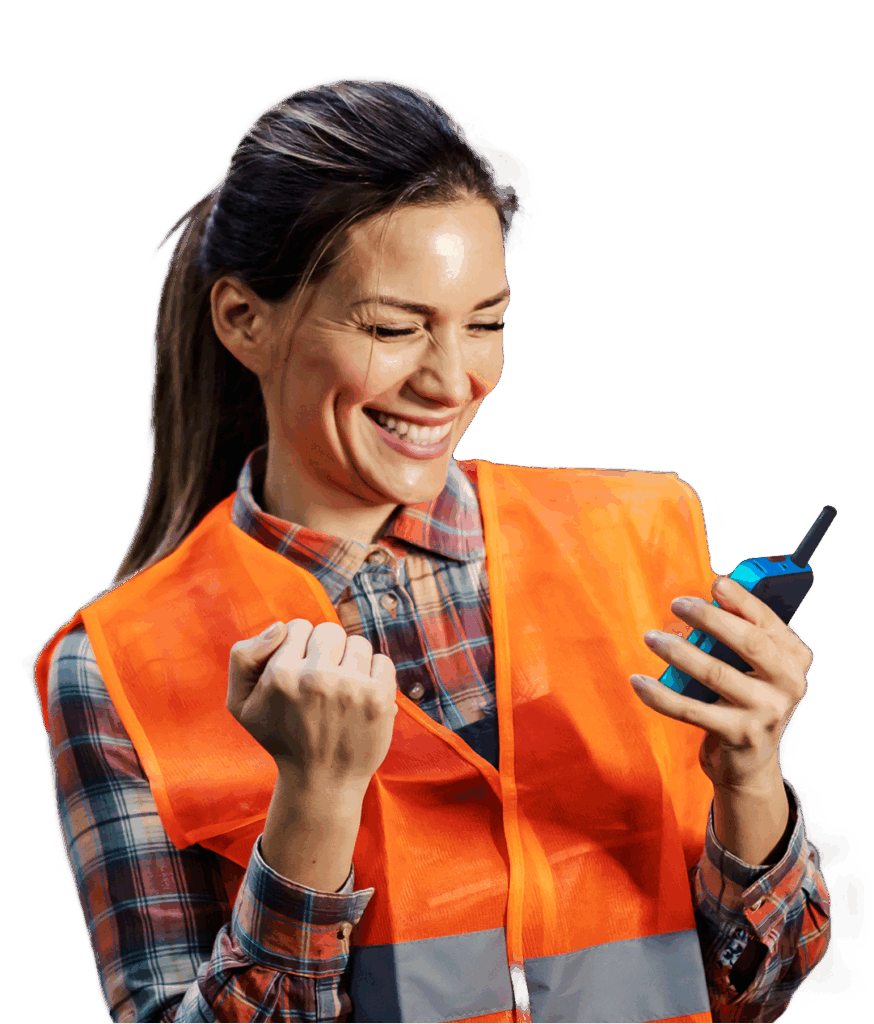Compare Solutions
Walt Smart Radio System vs. Smart Phones & Flip Phones
Phones — whether smartphones or flip phones — were never designed for frontline work. Smartphones create distraction risks and compliance liabilities. Flip phones are too limited to keep operations safe and efficient.

TL;DR
Smartphones: Versatile but fragile, distracting, short battery life, and not safety-certified.
Flip Phones: Simple and less distracting, but lack real-time push-to-talk communication, safety features, and scalability.
Walt Smart Radio System: Rugged, familiar, easy to hear in loud environments, geofencing, intrinsically safe, shift-long battery, enterprise-managed, with built-in safety and workforce features.
Bottom line: Be cautious when using consumer devices in hazardous settings. The Walt Smart Radio System was built for the frontline
Why This Comparison Matters
Phones have become the default communication tool for most of the world. Smartphones are powerful and connected, while flip phones remain a simple, low-cost option. But neither was designed for frontline industrial work.
Walt Smart Radio
Walt Smart Radio System comes in — purpose-built for the frontline, combining safety, ruggedness, and enterprise-scale communications in a distraction-free device.
- Rugged, C1D2 intrinsically safe, IP68 dust/water/drop resistant
- C1D2 certified; OSHA-aligned audit logs
- SOS with ID, GPS, lone-worker, compliance logs
Smart Phones
Smartphones create dangerous distractions. Workers miss alarms or walk into hazards while texting or streaming. OSHA has even issued regulations and fines around phone use near heavy equipment. Many manufacturers have responded with strict policies or outright bans, such as:
- General Motors: Prohibits smartphone use while walking in facilities
- FedEx: Restricts phones in operational areas near sortation equipment
Flip Phones
Flip phones avoid some of these issues, but they’re too limited: no group communication, no safety alerts, no compliance features.
- Not audit-ready
- Somewhat durable, but not intinsically safe
- No built-in SOS feature
- No PTT; voice only
Key Manufacturing and Operational KPIs
Enterprises judge communication tools by the effect they have on productivity, downtime, training, and compliance. This table compares how smartphones, flip phones, and the Walt Smart Radio System perform against the metrics that define frontline success.
KPI | Walt Smart Radio System | Smart Phones | Flip Phones |
|---|---|---|---|
Downtime | 15–20% reduction with dedicated channels and instant alerts | No reduction; prone to distraction and missed alerts | No reduction; communication gaps remain |
MTTR (Mean Time to Repair) | 20–30% faster with push-to-picture/video and searchable records | Slower; troubleshooting limited to calls/texts | Slower; voice-only limits knowledge sharing |
Shift Handoffs | Automated summaries and transcripts reduce errors | Informal, manual | Manual; no records kept |
Rework | 15–25% reduction through recorded, searchable exchanges | Higher; distractions and missed details cause quality issues | Higher; limited communication creates mistakes |
Onboarding | 40% faster with role-based channels and archived knowledge | Slow; consumer devices lack role-based setup | Slow; no continuity or records |
Compliance | Audit logs, intrinsic safety certification, and incident logging | Not audit-ready | Not audit-ready |
Feature Comparison
Side-by-side features reveal how consumer devices miss critical safety and compliance requirements, while the Walt Smart Radio System delivers purpose-built functionality for industrial environments. This table highlights the differences that matter most on the floor.
Feature / Capability | Walt Smart Radio System | Smart Phones | Flip Phones |
|---|---|---|---|
Coverage & Connectivity | LTE/Wi-Fi; weak indoors and remote | LTE/3G voice; limited data | |
Push-to-Talk/Group Comms | Native PTT with unlimited channels, group talk, private 1:1, broadcast | App-based; unreliable in poor coverage | No PTT; voice only |
Safety Features | SOS with ID, GPS, lone-worker, compliance logs | No built-in SOS; apps required | None |
Durability | Rugged, C1D2 intrinsically safe, IP68 dust/water/drop resistant | Fragile, consumer-grade, not intrinsically safe | Somewhat durable, not intrinsically safe |
Battery Life | 16–18 hours per shift | 6–10 hours heavy use | 10–12 hours |
Distraction Risk | None — locked down to work only | High (apps, texting, streaming) | Lower, but still personal texting |
Compliance & Safety Standards | C1D2 certified; OSHA-aligned audit logs | Not certified for hazardous environments | Not certified |
Cost of Ownership | Lower long-term TCO with lifecycle coverage and safety ROI (download MotoTRBO TCO versus Walt Smart Radio Guide) | Repairs + IT overhead + data plans | Cheap but low productivity |

Never Buy a Dumb Radio Again.
Why Phones Fail for Real Work
Specs don’t reveal the risks of using consumer devices in hazardous environments. This section highlights why smartphones and flip phones fall short in safety, coverage, and productivity compared to radios built for frontline work.
Safety & distraction risks
Smart Phones
Smartphones are designed to be addictive, which becomes a liability on the factory floor. Workers distracted by texting, social media, or games miss alarms and signals, putting themselves and others at risk. OSHA has cited companies for phone use near cranes and heavy equipment.
Flip Phones
Flip phones reduce distraction but provide no emergency features or compliance tools. Neither option meets the safety standards frontline operations demand.
Coverage & communication gaps
Walt Smart Radio ensures reliable communication across massive plants with LTE/Wi-Fi, plus FRS backup and SimulCast.
Smart Phones
Smartphones often struggle in large facilities.
Flip Phones
Flip phones are limited to one-to-one voice calls.
Built-in safety features
Walt Smart Radio includes:
- SOS with worker ID and GPS location
- Lone-worker monitoring
- Automated incident logging for compliance
Smart Phones
Phones require third-party apps to mimic safety alerts.
Flip Phones
Flip phones provide none.
Durability and intrinsic safety
Walt Smart Radio is C1D2 intrinsically safe, IP68 rated, and drop-tested — ready for industrial environments.
Smart Phones
Smart phones crack and fail under harsh conditions.
Flip Phones
Flip phones are tougher but not intrinsically safe.
Productivity and worker enablement
Walt Smart Radio strikes the balance: purpose-built for work, enabling group talk, private messaging, multimedia troubleshooting, and translation — all without personal apps.
Smart Phones
Smart phones pull workers into distractions.
Flip Phones
Flip phones limit communication to one-on-one voice.

Customer Proof
Customer outcomes show how replacing phones with purpose-built radios improves safety, productivity, and resilience. This case study highlights measurable results.
Howard Industries: America’s #1 producer of distribution transformers, relied on Verizon push-to-talk flip phones for years. In a facility spanning 2.4 million square feet with 4,500 employees, the limitations became dangerous and costly: safety risks, long response times, and lost knowledge when turnover occurred.
After adopting the Walt Smart Radio System, Howard Industries achieved:
- Enhanced safety with SOS alerts and contained comms
- Faster troubleshooting with photos and video sharing
- Reduced downtime through dedicated channels
- Business continuity during a cyber incident that disabled email
- Knowledge retention to reduce the impact of turnover
“Walt Smart Radio is the next generation of push-to-talk. It’s not just push-to-talk—it’s smart push-to-talk. I put Walt Smart Radio above everybody else in the market.” – VP of IT at Howard Industries
A Trusted Partner in Frontline Enablement
Conclusion
Phones — whether smartphones or flip phones — were never designed for frontline work. Smartphones create distraction risks and compliance liabilities. Flip phones are too limited to keep operations safe and efficient.
The Walt Smart Radio System eliminates both problems. It’s safer, more rugged, and built for enterprise-scale communication, with features phones simply don’t offer.
Ready to move beyond phones on your factory floor?

Frequently Asked Questions
Can smartphones replace radios in industrial environments?
No. Smartphones lack push-to-talk channels, built-in safety alerts, and intrinsic safety certification.
Are flip phones safer than smartphones?
Not really. Flip phones avoid some distraction but still let workers text personally — and they have no safety stack, no SOS, and no compliance tools.
How does Walt Smart Radio reduce distractions compared to phones?
How long does Walt Smart Radio last compared to phones?
Walt runs 16–18 hours on a single charge — longer than smartphones, and with more functionality than flip phones.




